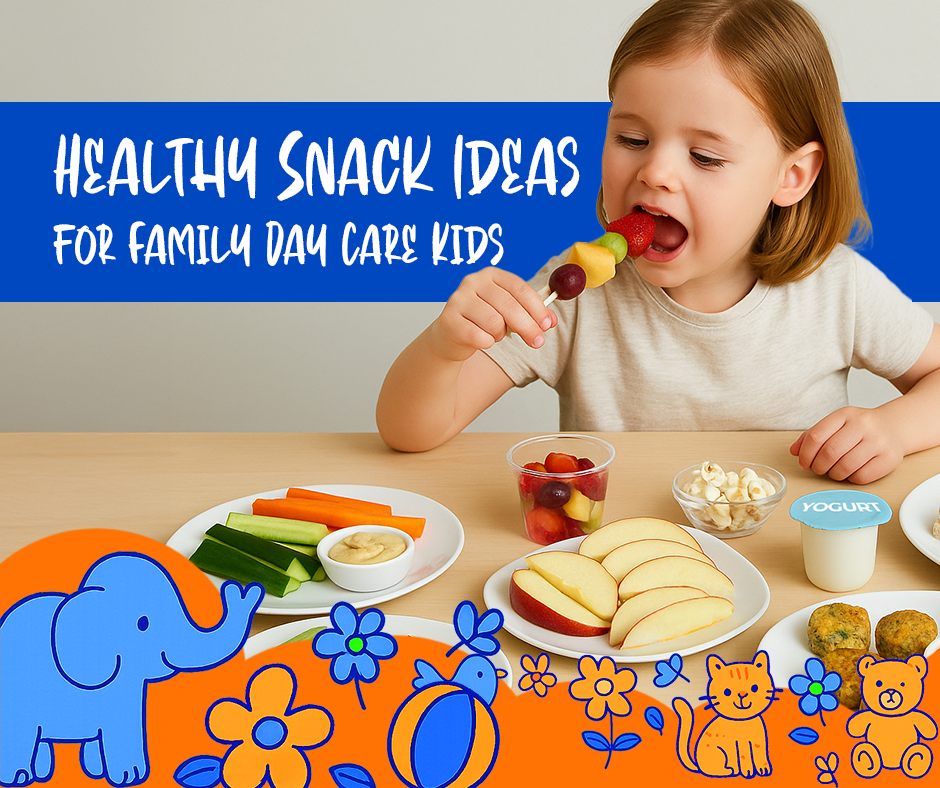Running a family day care means balancing playtime, naps, and meals—all while ensuring kids get the energy they need without crashing into sugar-fueled chaos. Snacks are a big part of that equation.
In Australia, where childhood obesity affects 1 in 4 kids, offering balanced snacks isn’t just a preference—it’s a responsibility.
Let’s cut through the noise and explore practical, no-fuss snack ideas that prioritise nutrition, safety, and fun.

1. Fresh Fruits and Veggies: Nature’s Fast Food
Kids often gravitate toward sweetness, but keeping it natural avoids added sugars. Fresh produce also packs vitamins and fibre, which support digestion and sustained energy.
🟢 Fruit skewers with yogurt dip
Thread chunks of seasonal fruit (melon, berries, pineapple) onto blunt sticks. Pair with unsweetened Greek yogurt mixed with a drizzle of honey. This combo provides natural sugars for quick energy and probiotics for gut health. Use child-safe skewers or straws to prevent injury and encourage self-feeding.
🟢 Veggie “fries”
Slice zucchini, carrots, or cucumbers into sticks. Serve with hummus or mashed avocado. The Healthy Kids Association notes that involving kids in prep (e.g., washing veggies) increases their willingness to try them. Offering a colourful mix turns snack time into a visual experience, which often leads to more adventurous eating. These can also double as an afternoon calming activity.
🟢 Frozen grapes
A hit in summer. Freeze seedless grapes for a refreshing treat. Avoid whole grapes for under-4s (choking hazard)—halve or quarter them. Their high water content also supports hydration on hot days. You can store small freezer-safe containers with ready-to-serve portions for convenience.
To learn about fruit and veggie colour benefits, see Nutrition Australia’s ‘Eat a Rainbow’ guide.
2. Protein-Packed Bites: Building Strong Bodies
Protein helps kids stay fuller longer and supports muscle growth. Opt for minimally processed options to avoid hidden salts and preservatives.
🟢 Hard-boiled eggs
Prep ahead, peel, and sprinkle with paprika for colour. Eggs provide choline, crucial for brain development. They’re also rich in B vitamins and healthy fats that keep energy levels stable. Store them in the fridge for up to a week for quick, hassle-free snacks.
🟢 Cheese and whole-grain crackers
Choose low-sodium cheeses like ricotta or mozzarella. Pair with crackers containing at least 3g fibre per serve. For advice on how to read labels, consult the Food Standards Australia New Zealand guide. The mix of protein and complex carbs helps reduce blood sugar spikes. Offering choices between different cracker shapes or cheese slices can make snack time more interactive.
🟢 Chickpea “cookie dough”
Mash cooked chickpeas with peanut butter, oats, and a touch of maple syrup. Roll into balls. For nut-free versions, use sunflower seed butter. This snack mimics the texture of cookie dough while being high in fibre and plant-based protein. Store in the fridge for a cool treat, or freeze for longer-lasting snacks.
3. Whole Grains: Steady Energy Without the Crash
Refined carbs (white bread, sugary cereals) spike blood sugar, leading to mood swings. Whole grains provide lasting fuel.
🟢 Mini savoury muffins
Bake spinach, grated carrot, and cheese into wholemeal muffin batter. Freeze batches for busy days. These muffins sneak in veggies and offer a balanced mix of fibre, protein, and fats. They’re great for lunchbox fillers or as part of a light afternoon tea.
🟢 Oatmeal energy bites
Mix rolled oats, unsweetened shredded coconut, mashed banana, and a spoonful of almond butter. Shape into bites. These bites are portable, mess-free, and can be tailored to kids’ preferences with add-ins like dried fruit or seeds. Store in airtight containers for up to a week.
🟢 Air-popped popcorn
Skip the microwave bags. Sprinkle cinnamon or nutritional yeast over plain popcorn. It’s a whole grain that provides fibre and satisfies the need for crunchy snacks without added sugar or fats. For younger children, serve in small portions and monitor for chewing. Adding fun toppings gives it variety without compromising health.
4. Hydration: Keep It Simple
Sugary drinks contribute to tooth decay and empty calories. Keeping water as the main drink fosters healthy habits and supports optimal growth. Offering appealing yet simple options encourages kids to sip throughout the day and helps them recognise natural thirst cues.
🟢 Infused water
Add slices of citrus, cucumber, or mint to water jugs. Let kids decorate their cups with reusable stickers. This encourages hydration while offering sensory exploration. Rotating flavours weekly can maintain interest and excitement. It’s also a great way to subtly introduce new fruits or herbs.
🟢 Frozen “pops”
Blend puréed fruit (mango, strawberry) with water or coconut milk. Pour into ice-block moulds. These are free from artificial colours and preservatives found in commercial popsicles. Add fun-shaped moulds to make them more appealing to children. You can also sneak in spinach or carrot for an added nutrition boost.
5. Allergy-Friendly and Safe Options
Food allergies affect 1 in 10 Australian kids. Always check dietary restrictions. Providing safe alternatives reduces stress for both carers and families, and ensures every child can enjoy snack time without fear of reactions.
🟢 Sunflower seed spread
Replace peanut butter with sunflower seed butter on rice cakes. It offers a similar texture and taste without triggering common nut allergies. This alternative is rich in healthy fats, vitamin E, and protein. Always double-check labels for cross-contamination warnings.
🟢 Quinoa cups
Cook quinoa, mix with grated veggies and egg, bake in muffin tins. Gluten-free and versatile. These mini cups are nutrient-dense, with complete protein and fibre. They reheat well and can be served warm or cold, making them a flexible option.
🟢 Chia puddings
Mix chia seeds with mashed fruit and lactose-free milk. Let sit overnight in the fridge. The texture is fun and jelly-like, appealing to many children. Chia seeds are rich in omega-3s, fibre, and calcium—great for growing bodies. Top with berries or coconut flakes for added flavour.
6. Get Kids Involved: Building Healthy Habits
When kids help prepare snacks, they’re more likely to eat them. Involvement also teaches basic food skills and fosters a sense of pride and independence. Hands-on activities can boost fine motor development and make the entire experience more engaging for little ones.
🟢 DIY snack boards
Arrange apple slices, cheese cubes, and wholegrain crackers on a tray. Let kids build their own combinations. Let kids build their own combinations. This boosts autonomy and food curiosity. Giving children control over their plates often results in better eating habits and fewer mealtime battles. It also encourages motor skills and coordination.
🟢 Smoothie stations
Provide frozen fruit, spinach, and milk. Let them pour ingredients into a blender (with supervision). Offering choices empowers kids and teaches them what goes into their snacks. Add labelled jars for ingredients to create a mini “smoothie bar” feel. Smoothies are also an easy way to sneak in extra veggies or protein powder.
Final Tips for Family Day Care Providers
👉 Portion control
Use small cups or muffin liners to avoid overwhelm. Young children need smaller portions to avoid waste and to match their appetite. It also supports healthy eating cues like stopping when full.
👉 Safety first
Avoid hard, round foods (e.g., whole nuts) for under-5s. Always supervise meal and snack times. Cut food into age-appropriate sizes and textures to prevent choking.
👉 Seasonal and local
Hit farmers’ markets for affordable, fresh picks. See Sustainable Table for Aussie seasonal produce guides. Local produce is often more nutrient-dense and supports the community economy.

Closing
Healthy snacking in family day care isn’t about perfection—it’s about offering variety, keeping it real, and making nutrition approachable. With these ideas, you’ll fuel little bodies, spark curiosity, and maybe even win over the pickiest eater.
For more guidance, explore the Australian Government’s Get Up & Grow resources or the Raising Children Network’s healthy eating hub.
